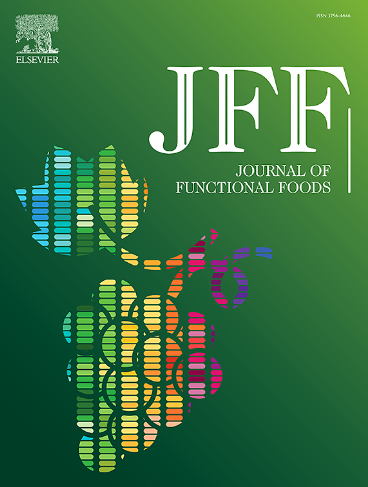Efficacy of nutritional plant-based extracts from Aframomum citratum and Xylopia parviflora in mitigating epididymal and excrement fat accumulation in DIO-C57BL/6 mice
IF 3.8
2区 农林科学
Q2 FOOD SCIENCE & TECHNOLOGY
引用次数: 0
Abstract
Obesity is a major global health issue, frequently exacerbated by high-fat diets (HFDs), which contribute to adverse metabolic outcomes. This study investigates the efficacy of extracts from nutritional plants Aframomum citratum (C.Pereira) K.Schum and Xylopia parviflora Spruce in modulating selected anthropometric parameters and fat deposition in DIO-C57BL/6 mice. Over 30 days, we observed that the extracts significantly attenuated body mass index (BMI) and apparent fat mass index (aFMI) in treated mice compared to HFD controls. Notably, X. parviflora at 200 mg.kg−1 BW (body weight) effectively reduced both visceral and subcutaneous adipose tissues, while orlistat served as a comparative benchmark. Lipid profile assessments revealed significant decreases in triglycerides, total cholesterol, and fatty acid contents in the epididymal fat pads of treated animals. Gas chromatography-mass spectrometry (GC–MS) analysis confirmed these findings and also indicated that treatment with the extracts enhanced the excretion of fatty acids, suggesting a potential mechanism of lipid malabsorption. Furthermore, histological analyses revealed a marked decrease in adipocyte size in treated groups, indicating a considerable decline in fat deposition. These findings suggest that bioactive compounds, particularly phenolic acids and flavonoids, found in A. citratum and X. parviflora extracts exhibit significant anti-obesity properties, positioning them as promising natural therapeutic agents for managing diet-induced obesity. Future research should focus on elucidating the mechanisms responsible for these effects and assessing their clinical applicability. This study contributes valuable insights into the role of dietary interventions in obesity management, with implications for the development of novel therapeutic strategies.

枸橼和小木营养植物提取物对DIO-C57BL/6小鼠附睾和粪便脂肪堆积的影响
肥胖是一个主要的全球健康问题,高脂肪饮食(HFDs)往往会加剧肥胖,导致不良的代谢结果。本研究探讨了营养植物阿芙拉姆·柠檬酸(C.Pereira) K.Schum和小花木(Xylopia parviflora Spruce)提取物对DIO-C57BL/6小鼠人体测量参数和脂肪沉积的调节作用。在30天内,我们观察到与HFD对照组相比,提取物显著降低了治疗小鼠的体重指数(BMI)和表观脂肪质量指数(aFMI)。值得注意的是,在200毫克的剂量下。kg−1 BW(体重)可有效减少内脏和皮下脂肪组织,而奥利司他可作为比较基准。脂质谱评估显示,治疗动物的附睾脂肪垫中甘油三酯、总胆固醇和脂肪酸含量显著降低。气相色谱-质谱(GC-MS)分析证实了这些发现,并表明用提取物处理可以促进脂肪酸的排泄,提示脂质吸收不良的潜在机制。此外,组织学分析显示,治疗组脂肪细胞大小显著减少,表明脂肪沉积显著减少。这些研究结果表明,在枸橼酸和细花x.m uviflora提取物中发现的生物活性化合物,特别是酚酸和类黄酮,具有显著的抗肥胖特性,使它们成为治疗饮食性肥胖的有希望的天然治疗药物。未来的研究应侧重于阐明这些作用的机制并评估其临床适用性。这项研究为饮食干预在肥胖管理中的作用提供了有价值的见解,对开发新的治疗策略具有重要意义。
本文章由计算机程序翻译,如有差异,请以英文原文为准。
求助全文
约1分钟内获得全文
求助全文
来源期刊

Journal of Functional Foods
FOOD SCIENCE & TECHNOLOGY-
CiteScore
9.60
自引率
1.80%
发文量
428
审稿时长
76 days
期刊介绍:
Journal of Functional Foods continues with the same aims and scope, editorial team, submission system and rigorous peer review. We give authors the possibility to publish their top-quality papers in a well-established leading journal in the food and nutrition fields. The Journal will keep its rigorous criteria to screen high impact research addressing relevant scientific topics and performed by sound methodologies.
The Journal of Functional Foods aims to bring together the results of fundamental and applied research into healthy foods and biologically active food ingredients.
The Journal is centered in the specific area at the boundaries among food technology, nutrition and health welcoming papers having a good interdisciplinary approach. The Journal will cover the fields of plant bioactives; dietary fibre, probiotics; functional lipids; bioactive peptides; vitamins, minerals and botanicals and other dietary supplements. Nutritional and technological aspects related to the development of functional foods and beverages are of core interest to the journal. Experimental works dealing with food digestion, bioavailability of food bioactives and on the mechanisms by which foods and their components are able to modulate physiological parameters connected with disease prevention are of particular interest as well as those dealing with personalized nutrition and nutritional needs in pathological subjects.
 求助内容:
求助内容: 应助结果提醒方式:
应助结果提醒方式:


